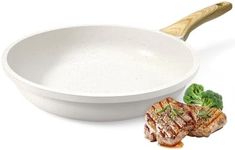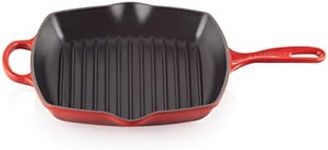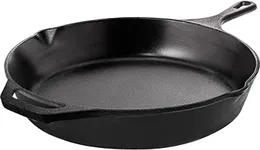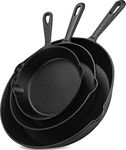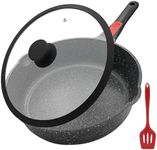Buying Guide for the Best Skillets
Choosing the right skillet can make a significant difference in your cooking experience. Skillets come in various materials, sizes, and designs, each suited for different types of cooking. Understanding the key specifications will help you select a skillet that meets your needs and enhances your culinary skills.MaterialThe material of a skillet affects its heat conductivity, durability, and maintenance. Common materials include cast iron, stainless steel, non-stick, and carbon steel. Cast iron retains heat well and is great for searing, but it requires regular seasoning. Stainless steel is durable and resistant to rust, ideal for browning and deglazing. Non-stick skillets are easy to clean and perfect for low-fat cooking, but they can wear out over time. Carbon steel is versatile and heats up quickly, suitable for high-heat cooking. Choose a material based on your cooking habits and maintenance preferences.
SizeSkillets come in various sizes, typically measured in inches across the top. Common sizes range from 8 to 12 inches. Smaller skillets (8-10 inches) are ideal for single servings or small meals, while larger skillets (10-12 inches) are better for family-sized portions or cooking multiple items at once. Consider the number of people you usually cook for and the types of dishes you prepare to determine the right size for you.
HandleThe handle of a skillet affects comfort and safety during use. Handles can be made from metal, plastic, or wood, and may be riveted or welded to the skillet. Metal handles are durable and oven-safe but can get hot, requiring a pot holder. Plastic and wood handles stay cooler but may not be oven-safe. Ergonomic handles provide a comfortable grip and better control. Choose a handle that feels comfortable in your hand and suits your cooking style.
WeightThe weight of a skillet influences its ease of use and heat retention. Heavier skillets, like cast iron, retain heat well and provide even cooking but can be difficult to maneuver. Lighter skillets, such as non-stick or aluminum, are easier to handle but may not retain heat as effectively. Consider your strength and comfort level when choosing the weight of your skillet.
CompatibilityCompatibility refers to whether a skillet can be used on different types of cooktops, such as gas, electric, induction, or in the oven. Not all skillets are suitable for all cooktops. For example, cast iron and stainless steel skillets work well on most cooktops, while non-stick skillets may not be induction-compatible. Check the manufacturer's specifications to ensure the skillet is compatible with your cooktop and intended use.
MaintenanceMaintenance involves the care required to keep your skillet in good condition. Cast iron skillets need regular seasoning to prevent rust and maintain their non-stick surface. Stainless steel and carbon steel skillets require thorough cleaning to avoid staining and rust. Non-stick skillets are easy to clean but should be handled gently to avoid damaging the coating. Choose a skillet with maintenance requirements that fit your lifestyle and willingness to care for it.


